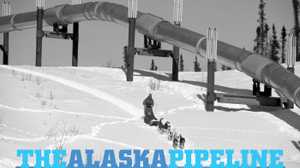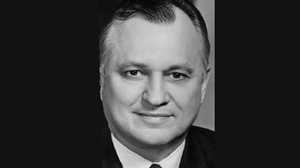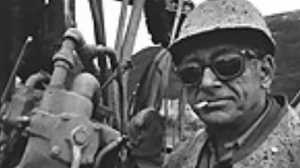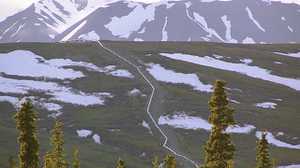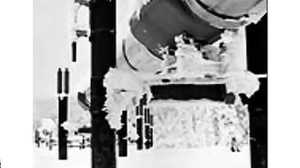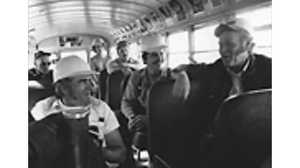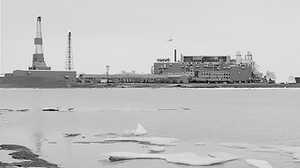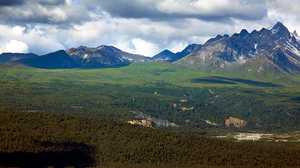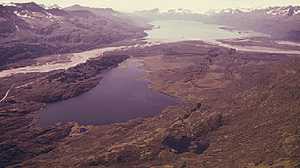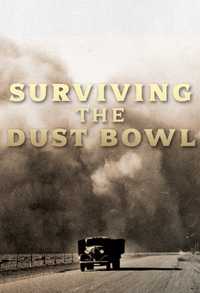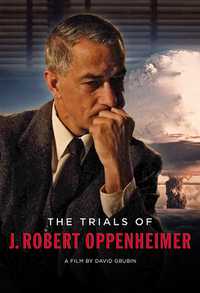Narrator: Alaska, 1976: the welders from Oklahoma were ready to quit.
The last thousand feet of the Alaska pipeline had to scale an almost sheer cliff. It looked impossible, and no one was willing to risk his life on that rock face -- until the oldest man on the job volunteered.
Junior Leslie: I was scared, and everybody else was scared too. But I was going to go if I lost my life... after so many of 'em tell me, it can't be done.
Narrator: On the Alaska pipeline, there was always something that couldn't be done... that had to be done.
It was an 800-mile steel pipe through the heart of America's last untouched wilderness... the biggest, most expensive, and most controversial private enterprise in American history.
Diane Benson: There were times when we felt just militant about it. Oh, let's just blow this thing up. You know, let's make it stop.
J. B. Carnahan: It was like a gold rush. We had people from almost every country and from every walk of life. Plus along with that you had gamblers and crooks and ladies of the evening. Everybody who could had some piece of that pipeline.
Howard Weaver: This was not about details, man. It was about muscle. I don't care what it takes. Do it. That was a pretty good answer to money questions. That was a pretty good answer to environmental questions. It was a pretty good answer to political questions. I don't care what it takes. Do it. And the evidence would suggest that they didn't care what it took and they did it.
Narrator: On April 22, 1970, 20 million people marched in cities across the U.S. in the first Earth Day demonstration. A movement building for years had reached critical mass. Now, they were ready to fight back. The timing could not have been better for the new environmentalists or worse for the oil industry, which was on the verge of launching the biggest private construction project in history, in America's most pristine wilderness.
Two years earlier, Atlantic Richfield struck oil at Prudhoe Bay, on Alaska's North Slope. It was a massive strike, the largest oil field ever discovered in North America. Other oil companies joined in and started drilling their own wells. The biggest problem anyone could foresee was how to get 10 billion barrels of oil out of Alaska.
There wasn't even a road within 400 miles of the wellheads. The Arctic Ocean was frozen solid most of the year. The oil companies considered ice-breaking tankers, nuclear-powered submarine tankers, and twelve-engine jumbo jet tankers. Eventually, they agreed that the only practical solution was a pipeline.
The shortest route would run 800 miles through the heart of Alaska, from Prudhoe Bay on the northern coast to the port of Valdez in the south, equivalent to building a pipeline from Minneapolis to Oklahoma City, but with an Arctic wilderness in between. It was country so wild, some of it had never been mapped.
The pipeline would cross three mountain ranges, 800 streams and rivers, and some of the world's most active earthquake zones before reaching the ice-free water in the south. It was an audacious plan, even for the oil industry.
Joseph Pratt, oil historian: The industry was somewhat beyond confidant that they had the know-how and the money to solve any engineering problems they encountered, they believed. And when you think of that kind of confidence, it does border on arrogance, and it does border on hubris, given what happened next.
Narrator: In February 1969, the oil companies announced their pipeline plans. They ordered $100 million worth of steel pipe from Japan. The project would cost 900 million dollars, they said, and be finished by 1972, even though they did not yet have a single design drawing or construction permit.
Stewart Brandborg, former director, Wilderness Society: They had no concept how this thing would be built, and yet the industry was ready to lunge ahead. "Don't worry folks, we're taking every precaution. Leave it to us and everything will be fine. And besides you couldn't possibly stop us. You couldn't possibly slow this thing up. It's too big. We need the oil; we're going to get it."
Narrator: Stewart Brandborg, director of the Wilderness Society, decided to lead the fight against federal approval of the pipeline, much of which would cross public land.
Stewart Brandborg: I saw no recourse. If the environmental movement hadn't challenged the pipeline we would have ended with damage beyond any description.
Narrator: Native Alaskans were also alarmed. Ever since the Alaska Purchase in 1867, they'd been waiting for Congress to settle their ancestral land claims. They were still waiting in 1969 when the Native leaders of Stevens Village heard about the pipeline.
Byron Mallott, First Alaskans Institute: Stevens Village was located directly in the proposed path of the pipeline. And the people of Stevens Village said, we can't let this happen. That until our claims are settled, until we have certainty about what we own and what we don't own and how this will affect us and our children, we can't allow this to happen.
Narrator: While Earth Day demonstrators took to the streets in April 1970, Native Alaskans and environmental groups both sued in Federal Court -- and won -- stopping the pipeline until their concerns were addressed. Now, Native Alaskans had leverage they'd never had before.
Byron Mallott: Suddenly the game changed. The Alaska Native community went from the prospect of settling our land claims for mere pennies an acre and no land, to very quickly what we were able ultimately to achieve: 44 million acres of land and a billion dollars.
Narrator: Environmentalists also had newfound leverage, thanks to the National Environmental Policy Act, which had just been signed into law. NEPA required the government to evaluate environmental threats and alternatives before authorizing any project on public land and environmentalists could challenge the results in court.
Joseph Pratt: In 1970, suddenly, the environmentalists weren't just talking from the outside. They had some new weapons, and some new power and some new standing, to push over, to bridge the gap and to say, in your construction process, you are going to have to listen to new demands.
Narrator: Environmentalists used the law to force studies of everything from caribou migration in the far north to fish spawning in the streams and rivers the pipeline would cross.
They pushed for detailed plans to limit pollution from construction camps, prevent oil spills, and survive earthquakes. One legal challenge followed another, as environmental groups tested the limits of the new law. Years passed with the pipeline stuck in legal limbo.
Not everyone in Alaska wanted the pipeline, but many were counting on it for an economic boost, and blamed outsiders for meddling in their business.
Howard Weaver, journalist: Environmentalists were painted in very dire terms. I can remember the Anchorage Times once describing someone in an editorial as being an "admitted" environmentalist.
Narrator Howard Weaver grew up in Alaska, and was a reporter for the Anchorage Daily News during the pipeline years.
Howard Weaver: People in Alaska really thought that the psychic benefits of somebody in Iowa or Boston, who's never going to come here, who has never lived through an Alaska winter, who doesn't have to make a living here, who's not raising kids here... screw 'em. You know? I mean, preserve your own space. Of course, we weren't hungry for grandeur. We weren't hungry for, for vast open spaces. We had them. You know, that's what we had plenty of. What we didn't have plenty of was decent high schools, flush toilets in bush villages, you know, those are nice things too.
Narrator: Environmentalists weren't the only obstacle. Even without the lawsuits, the Interior Department would still have to approve the project, and as early as 1969, their geologists had serious doubts about the pipeline-engineering plan. One of them was Art Lachenbruch.
Art Lachenbruch, U.S.G.S.: The advocates of the pipeline were pushing very hard for approval, and they hadn't demonstrated whether the pipeline as proposed, would work.
Narrator: The oilmen planned to build the Alaska pipeline the same way they'd built every other pipeline in the world -- dig a ditch and bury it. Lachenbruch warned federal officials that this would not work in the arctic.
Beneath a thin, insulating cover of tundra and vegetation, much of Alaska sits on permanently frozen ground called permafrost. In some places, it's mostly gravel, but in others it's mostly ice.
If ice-rich permafrost is allowed to thaw, it turns into loose mud that cannot support any weight. Prudhoe Bay oil would come out of the ground hot, and as it flowed through a buried pipe, it would thaw any ice-rich permafrost along the way. The unsupported pipe would eventually buckle, break apart, and start leaking oil. Lachenbruch's warning reached the Secretary of the Interior, who put the oil companies on notice.
Walter Hickel (archival): ...and I can guarantee that we will not approve any design based on the old faulty concept of build now and repair later.
Art Lachenbruch: And the next Monday my office was full of pipeline people, and that led to a very intense discussion that went on for over three years.
Narrator: The oilmen had formed a company called Alyeska to design and build the pipeline. That job that now entailed drilling 15,000 soil samples along the route to locate all the areas of ice-rich permafrost. As it turned out, more than 400 miles of the line would have to be built above ground. By the summer of 1973 the government was satisfied that the permafrost problem had been solved, but environmentalists still had the pipeline tied up in court.
Worried about oil spills from tanker traffic along the coast of southern Alaska, they were now pushing for consideration of an alternate route through Canada to the upper Midwest -- a process sure to cause years of further delay. Pipeline advocates were fed up. They began promoting special legislation that would prohibit any more legal challenges.
Senator Ted Stevens (archival): We are on the course of closing off judicial review by the environmental extremists who do not want any development in the north.
Stewart Brandborg (archival): The oil industry has used a campaign of several months, ads on the television, newspaper ads -- full page -- everything they could use including the grossest intimidation of the members of the Senate.
Stewart Brandborg: This was a showdown fight!
Narrator: When it came to a vote the Senate was deadlocked at 49-49. Vice president Spiro Agnew cast the deciding vote in favor. With the vote so close, there was still a chance it might not be approved by Congress. But another conflict was about to intervene.
October 1973, in retaliation for American support of Israel in the Yom Kippur War, Arab states declared an embargo on oil shipments to the U.S. The price of oil doubled overnight. Shortages led to gas lines, gas rationing and sometimes no gas at all.
Pipeline supporters said that Prudhoe Bay would produce two million barrels of oil a day, cutting imports by one third.
Senator Henry Jackson (archival): We're importing too much oil from abroad. We're importing, this year, 35 percent of all our oil. Now that is bad! It's bad from a diplomatic point of view because it subjects the United States to blackmail. And the man in the street wants to ask, well, if we can import it from the Middle East and every other place in the world that's substantially insecure, why can't we import it from Alaska?
Narrator: In November 1973, the Trans-Alaska Pipeline Authorization Act passed the House easily. There could be no further legal challenges.
It took an act of Congress to end the battle, but the years of lawsuits produced volumes of environmental safeguards, which now had the force of law.
For the oil industry, the price of victory would be more scrutiny and regulation than they had ever faced before.
Narrator: The energy panic put enormous pressure on Alyeska to get the pipeline built quickly. But the pressure from their oil company owners was even greater. They had already spent billions at Prudhoe Bay, and they were losing 22 million dollars a day in revenue while the oil sat in the ground.
They made it clear to Alyeska that the pipeline had to be up and running in three years, no matter what.
Bill Howitt, engineer: The popular rumor was that if we didn't start it up on schedule Sohio was in danger of having to declare bankruptcy within 30 days. This had taken some of the giant old companies, some of the biggest oil companies in the world like Standard Oil, British Petroleum, and stressed their financial wherewithal to the absolute limit.
The first job was to build a supply road through the trackless northern half of the state, from the Yukon River just north of Fairbanks to Prudhoe Bay ... and then 29 construction camps along the pipeline route to house the workers.
Narrator: Alyeska finally went to work at the end of January 1974. They had to haul in road building equipment and temporary housing while the ground was still frozen. By spring the tundra would be too soft to drive on. Cargo planes flew in more freight, landing on frozen lakes.
By fall, the 360-mile-long, gravel road was finished, and the race was on to be ready for construction the following spring. Three million tons of pipe, machinery, spare parts, fuel and food would be hauled in over the next two-and-a-half years.
Dave Smallwood, pipeline truck driver: It was just bumper-to-bumper traffic. It was pretty much insanity. It didn't really pay to pass the guy ahead of you. Well, I was living on the road back then. Just one trip after another. We didn't have a scale. We didn't have logbooks. Virtually just lived in the trucks and ate in the camps. I'd get into town and just load and go. If you met another truck that didn't know you was coming, if you just clicked your mirrors you'd call that a good pass. And the motto then was crowd the other guy, not the ditch. Because you'd end up over in the ditch laying on your side. It was a long way down in a lot of spots.
Narrator: At the end of March 1975, it was time to start laying pipe. No one had ever attempted construction on this scale in such an extreme environment... under such intense scrutiny... or on such a tight schedule.
The only hope of finishing on time was to divide the route into five segments and build them simultaneously.
The man in charge of getting it done for Alyeska was Frank Moolin, a veteran big project engineer who had just finished BART, San Francisco's rapid transit system. He was a tireless worker who knew how to motivate.
Bill Howitt: You kind of got the feeling like if you didn't do your part this whole thing was going to fall apart. You know, there's 20,000 guys working on this thing, you know, but, but that's the way you felt when you talked to Frank. And you felt like you didn't want to let him down.
No one worked harder than he did. Friends believe his relentless style contributed to an early death not long after the pipeline was done.
Bill Fowler, assistant project manager: He was a totally driven individual, extremely bright, very demanding. If it hadn't been for Frank it wouldn't have happened.
Narrator: Moolin would live in a helicopter for the next two years, trying to keep the sprawling, complicated project on track.
There were hundreds of streams and rivers to cross, twelve pump stations to build, plus a tanker port on the coast at Valdez.
And then there was the pipe -- 800 miles of it -- to be welded together 40 feet at a time.
If the ground was stable, it could be buried like any other pipeline.
But 420 miles of the route passed through unstable permafrost, where the pipe would have to be built above ground and then insulated to keep the oil fluid in cold weather.
Nothing like it had ever been done before.
The massive scale of the operation made everything more difficult.
Bill Fowler: Housing, telephones, electricity, everything was in short supply, or no supply. They just sapped up all the equipment that was available, and it was just like that. I've hired aircraft, spent $10,000 to go get a $50 item for a Caterpillar tractor to get it started so we can keep moving. How many dollars a day were they spending -- $30 million dollars a day, $20 million dollars a day? And the production is being held up because of a widget? You know, it doesn't matter what it takes to get the widget; go get the widget.
The one thing not in short supply was people hoping to cash in on the project. Working seven days a week, 10 or 12 hours a day, pipeline workers earned three or four times what they could make anywhere else in the country.
Al Fleming, pipeline teamster: June of 1975: I opened up my Time Magazine, and there was an article on the Alaska Pipeline. And it had a picture of a fellow on the pipeline showing his check to the camera. And that check was about 1500 dollars for a week! And I made a thousand dollars a month! I was a schoolteacher. I had four children. We didn't have enough money to live on. I looked at that picture, and I said, "That's me! Verna," that's my wife, "we're going."
Thousands of people got the same idea.
J. B. Carnahan, Fairbanks police department: It was like a gold rush. We had people from almost every country and every walk of life. It was the last of the frontier. Those of us who were here got a chance to live through probably the last American frontier.
Narrator: Fairbanks was a boomtown, jammed with pipeline workers spending money as fast as they could.
J. B. Carnahan: It was like a circus every night. People coming into town with three, four, five thousand dollars of cash in their pockets. Suddenly women that we'd never seen around town before were appearing from places like Florida and New York and suddenly we had reports of gambling going on. I mean everybody who could have some piece of that pipeline.
Howard Weaver: We know for sure that major organized crime figures looked at it as an opportunity. Nevada, who cares about Nevada? We've got 25,000 construction workers earning $100,000 bucks a year in a place where there are ten men to every woman, you know, you don't exactly need an MBA to figure that one out.
Fairbanks was a brief stop for the majority of pipe liners. Most were shipped off to one of the construction camps out on the line.
Song: "Livin' in a pipeline camp..."
Camp Announcer: Current weather at Chandalar, winds are calm, visibility is 15 miles...
Song: "... Well I come up here to make some good money and pay off my bills behind..."
Old man: Well, it's good livin' like I told ya. Ya got good maid service, everything is clean. Clean life. I never lived like that all my life.
Diane Benson, pipeline truck driver: There were a lot of people who felt like, I mean, "This is the good life." It was definitely exciting, but it was really tough. It's tough for a woman, for one.
Thousands of women got into construction for the first time on the pipeline, thanks to affirmative action requirements in the federal permit.
Woman #1: I've been here for about two years, working on and off, driving busses, flatbeds, whatever they'll put me on, whatever I can drive. I'm your typical teamster.
Woman #2: I came to the pipeline because the job was offered to me, and at the time, I wanted to know if there was anything I could do besides being a mother and a wife.
Larry Houle, pipeline welder's helper: Franklin Bluffs was one of the biggest camps, and I took a count one day, and I'll always remember the number: 1100 men, 97 women. And ah, those are pretty good odds for some, and pretty poor odds for the others.
Narrator Diane Benson was a Tlingit Indian from southeast Alaska who joined the Teamsters and lived in pipeline camps for three years.
Diane Benson: Camp life was being in a shower and having a guy walk in on you to do his laundry. Or, walking down the hall and having a guy grab you. It was also dealing with things like eating in the mess hall one time eating chicken and you know, you've got to eat it with your fingers, and all the guys staring at me at the table as if that was the most erotic thing they'd ever seen.
It was hard to be a woman up there and try to maintain your dignity, if you had any, you know, or wanted any. But this was one big adventure. And I loved it. I said, you could pay me a dollar a day and give me room and board and I would be happy to do this job, because I loved it that much.
Narrator: Alaska was booming for lots of people, but for many latecomers to the gold rush, it was a bust. Pipeline work was supposed to go to Alaska residents and people with special skills first.
The rest went on the waiting list.
Al Fleming: There was a line at the Teamster hiring hall that was about five blocks long. You'd go to the Labors Hall it was the same thing. You'd go to the Operating Engineers Hall, it was the same thing. Well, that was discouraging because there was no chance, they said.
Gary Atwood, Teamster business agent (archival): There's at least 2000 in this area signed up, 2000 in the Anchorage area on the waiting rolls, and most of these, like I said, I don't think will make it. They haven't got the financial resources to stay here for an extended length of period, and they will be, what you might call, "starving out" and heading back south.
Mr. Nichols (archival): I can't find nothin' whatsoever. And here I am just stranded up here and can't move either way. And, um, so it's a situation that I hope nobody else comes up here lookin' for work, because it's a bad situation. There's nothing here, and so I just made a wrong move. That's about it.
Narrator: One day Al Fleming heard that a bribe to the right person at the Teamster Hall could make a difference.
Al Fleming: It was said that this fellow would, for an amount of money, backdoor you through the union so you get a job. That's what I was told. And so I decided that I would go down there and meet this guy.
Fleming offered his first two weeks pay, and within a few days he had a job in the Teamster warehouse in Fairbanks.
Al Fleming: Well it changed my life! Everybody made a thousand dollars or more a week! A thousand dollars a week? In 1975? I thought, I'm going to buy the whole state!
By late summer 1975 there were 27,000 workers on the job, and Frank Moolin was determined to have 400 miles of pipe in place by the end of the year.
The critical and highly skilled job of welding pipe was the exclusive domain of the pipeline welders union Local 798, out of Tulsa, Oklahoma -- 798, for short.
They were a close-knit clan who guarded their turf jealously.
Jimmy Pedigo, pipeline welder: A lot of people can weld, but can you make that perfect weld, every time, every day, 10 hours a day, month after month after month? It would be like penmanship. You've got a lot of people that can write real pretty. And then some people can't; they can just write to get by. That's, that's the difference. To make a good pipeline welder you've got to have that penmanship.
Pete Hughes, pipeline welder: The quality of the work and welding was better on this job than any other job I been on. It had to be. It was inspected more, and they expected more of you. It was publicized; it was a big thing, and everybody was looking down your throat.
Narrator: 798ers were notorious, not only for their skill, but for their attitude. They were the highest paid and most demanding workers on the job.
Bill Howitt: The stories preceded them: very, very talented, very, very arrogant, insisted on their own way... 798ers knew they were good. They knew that we couldn't build this thing without them, and they pushed it a little bit.
Jimmy Pedigo: "Prima donnas" in Alaska; that was a word they used a lot. I know there was a saying up there that happiness was an Okie flying south with a Texan under each arm. So I guess they was referring to, to us, you know.
The welders controlled the pace of work, so whatever they wanted, they got. Winter was coming, and Frank Moolin knew that staying on schedule would get harder as the temperature dropped.
Frank Moolin: You know, Alaska's got some of the worst environmental and weather conditions in the world. It's not unusual to get down to minus 45, minus 50, minus 60 degrees in the wintertime.
Narrator With a little luck, they could work into December before the conditions became impossible.
Alyeska provided arctic gear and some training in how to use it.
But nothing could prepare a person for the North Slope, where the sun never rises for two months in the winter, and wind chill temperatures can reach 115 below zero.
Todd Hoener, pipeline laborer: The first time I landed in Prudhoe Bay, it was a spooky place. You didn't see much out the window. It was dark. And then you started seeing down below some lights and maybe a flare. This was the end of the earth.
We've got our parkas on. Some sort of facemask to keep you from getting frostbite. We're getting ready for battle out there in the elements. There was a saying in Prudhoe Bay that the wind never blows, it sucks.
When you're working at night on the North Slope, the wind is usually blowing, the snow is usually blowing. The communication is marginal, and the smoke from the diesel engines, the cold, the chaos... it was surreal. And we continued that for 10, 12 hours. And I am sure by the end of the night everybody wanted to quit and just go home.
On the southern half of the line, workers could drive to nearby towns after work. But north of the Yukon River, there was nowhere to go.
Worker: You do get a closed in feeling here, because, like I said, this is it. These three or four acres right here. This is all I see. Every day.
Larry Houle: Camp life got to be... repetitious. You'd get up at the same time everyday, you'd hit the same bus with the same hands, you'd head out to the same worksite, day after day, seven days a week. I did a 20-week stint, one time, which was pretty hard to do.
Narrator: Drugs and alcohol were prohibited in construction camps, but the rules were rarely enforced.
Larry Houle: I actually would bring booze into the camp. I'd bring trunk loads of it. I'd fly it in, or truck it in, and then I set up a little operation where I was actually bootlegging whiskey, and it was amazing to me. I kept pretty good records of this, and I might spend six bucks on a bottle of R&R, and I'd turn around and sell that for about $25.00. But the demand was huge, and I took advantage of that.
Diane Benson: You could tell what union somebody belonged to by what drug of choice they had. I mean it seemed like operators were the drunks or the Teamsters were the coke freaks and the laborers were the potheads. It got to the point where we had whole crews that would get loaded together, especially when you're working night crew.
Narrator: Drugs and alcohol weren't the only threats to productivity. All along the line there were equipment shortages, breakdowns, design changes, and unexpected encounters with permafrost. Workers often sat on busses for days with nothing to do while the engineers tried to solve problems ... and deal with the state and federal inspectors who monitored every step of the process.
Bill Fowler: Something like you know, 18 different agencies were represented, and every one of them had the ability to stop work because they had a question about what you were doing.
The project was also plagued with theft of everything from tools and food to pickup trucks and heavy equipment.
Much of it disappeared from North Star Terminal, the Teamster controlled facility where Al Fleming worked.
Al Fleming: A lot of things that were supposed to go up north or go down south somewhere never made it. Never made it. There was always talk that there was organized crime throughout the pipeline. And there was always talk that it permeated the union that I was part of, the Teamsters. One of the union leaders was murdered. The rumor was that it had to do with drugs.
The 798ers were busy living up to their reputation, tearing up mess halls, brawling with security guards, and alienating just about everyone else.
Some believed that Frank Moolin and his managers were losing control.
Howard Weaver: I can tell you what people on the street thought, was that it was a joke. That it wasn't exactly management. It was just you know, if you throw enough pickup trucks at this thing sooner or later one will make it up the hill.
Bill Fowler: Certainly there were excesses, certainly there were things that went wrong, certainly there was chaos. But when you try to put a project together like this you're undoubtedly going to make mistakes and have problems. It was kind of like a small war without guns... most of the time.
Somehow, though, the pipeline was getting built. Alyeska had negotiated no-strike clauses with the unions. What they gave in return were high wages, and tolerance for a certain amount of bad behavior.
Howard Weaver: They bought labor peace. They wanted to build the damn thing fast. They didn't want labor troubles and they were willing to pay for that. And I would say this about it - it worked! Despite incredible featherbedding, despite incredible waste, despite incredible theft, in the end, enough guys showed up with enough muscle and blood to build a pipeline. And so simply seen as a feat both of engineering and construction and project management, you'd have to say it was a moon shot.
Narrator: In mid-December 1975, extreme cold forced welding crews off the line for six weeks. Three hundred seventy-one miles of pipe was in place, just short of Moolin's 400-mile target.
So far, they'd beaten back every challenge with money and brute force. But a new crisis was about to hit, and this one threatened to take down the entire project.
Early in 1976 the national media reported that thousands of welds made in the previous year might be fatally flawed.
Walter Cronkite (archival): The Transportation Department, which sets safety standards for all pipelines, opens new hearings tomorrow on the trouble-plagued Alaska Pipeline. Those troubles threaten the fragile Alaskan environment, the timetable for delivering oil to the rest of the country, and the price of that oil.
Narrator: Every one of the 108,000 pipeline welds was supposed to be x-rayed, inspected for flaws, and certified... an enormous task that quickly overwhelmed the companies hired to do the job.
Bill Fowler: One of the subcontractors got behind and pulled a trick that had been learned in the industry long before, is that you find a good weld and you x-ray it 10 or 15 times from a different angle and then call it ten or fifteen different x-rays and then say, well, the next 15 joints are in good shape, now we can move ahead and you get caught up.
When the deception came to light, it was a major scandal and Congress demanded answers from those in charge.
Bill Howitt: It was disastrous because it threw the whole quality control program and quality assurance program for everything on the pipeline into question. It was like, well, if something as simple as an x-ray, you know, can't get done right, what, what else is buried?
Until Frank Moolin's people could sort out which x-rays had been faked, all 30,800 field welds to-date were under suspicion.
By laboriously crosschecking every x-ray, they were able to find the all the duplicates and narrow the number of suspects to 3955. More than half were in buried pipe, some beneath rivers.
Bill Howitt: You're already schedule driven, you've got every resource stressed, all right, now you're going to go out and dig up hundreds of existing places and x-ray them and re-weld them if you have to. And in the case of several river crossings actually go back in a couple of miles under a river and look at the weld.
Narrator: In the end, some 1900 welds needed minor repair. Another thirty-seven had to be cut out and re-done. It was an expensive and embarrassing setback. But the schedule suffered the most damage.
To get the oil flowing in 1977, they had to finish welding pipe before winter set in at the end of 1976, and that was looking more and more doubtful.
Bill Fowler: The owners told Frank that he could spend up to an additional $10 million dollars a day as long as what he spent it on would save a day.
Two of the most difficult sections remained -- the rugged mountain passes of the Brooks Range in the north, and the Chugach Mountains in the south.
In the Chugach, the problem was the roller coaster terrain, and the difficulty of getting machinery and pipe where it had to go.
One spot in particular presented problems that no one in the pipeline business had ever confronted before -- the near-vertical 2800-foot south face of Thompson Pass.
Bill Howitt: I was called in for a brainstorming session on how, how do we do this. And that's when Frank Moolin said, we don't know how we're going to build Thompson Pass. You got to be kidding here! You know, it's that steep? And there's no way to get stuff up and get stuff down and you can't even operate a Cat on it, and all of this sort of thing and we haven't figured out how we're going to do it?
Narrator: Eventually, the engineers eventually came up with a tower and cable and system to fly the 80-foot pipes sections into place. The cable operators had to maneuver the nine-ton sections into position with nothing but radio communication to guide them.
It worked well until the time came time to position and weld the final sections on the steepest part of the slope... at which point, the welders balked.
One man had already been injured by a falling rock, and most of the others decided it was too dangerous to continue.
With time running out, the managers turned to Junior Leslie, one of the oldest and most experienced welders on the job. At Thompson Pass, he saw a chance to repair the reputation of the 798 welders in Alaska.
Hugh "Junior" Leslie, pipeline welder: The superintendent come out and said, Junior, what are we going to do? And I said well, if nobody wants to go, I'll volunteer. Then, a little welder named Richard Behne came around and wanted to go. Then, then that kind of broke it. When I did that I didn't do it to be glorified or anything. I did it because it needed to be done. I did it for the union.
For the next few weeks, Junior Leslie and Richard Behne worked in a place where only rock climbers had ventured before.
Richard Behne: Every day you had the danger of the rocks hitting you or the pipe getting loose and comin' down on ya. It's the most dangerous job I've ever seen.
Hugh "Junior" Leslie: Snow, wind, rain, anything, sleet, anything you could imagine, I felt like I was tryin' to wash the windows on the Empire State Building.
Bill Fowler: They were taking their lives in their hands to work on it up there. That's what pipe liners do. That's probably one of the characteristics of 798 welders. [laughs] The good side.
On October 20th, the welders were done with Thompson Pass.
Hugh "Junior" Leslie (archival): Nothin' can compare with this. No mountain like Thompson Pass. This is the granddaddy.
Hugh "Junior" Leslie: Like I said, that was the granddaddy of them all.
Narrator: Five hundred miles to the north in the Brooks Range, they were still working on the last piece of the pipeline.
Atigun Pass was the highest point on the line, 4800 feet above sea level, with some of the most brutal weather in Alaska.
Frank Moolin: We have from 500 to 700 men working 24 hours a day in Atigun Pass, under some extremely difficult working conditions. Snowfall with very low temperatures, high winds...
The ground was unstable permafrost, which normally would require elevated pipe.
But the threat of avalanches meant that it had to be buried in a heavily insulated box filled with concrete. And they had to finish before the weather forced them off the line for the winter.
Bill Howitt: So, they're pouring concrete in November in the Arctic, cold, blowing snow, avalanche danger, just terrible conditions.
Narrator: Working around the clock, they finished in Atigun Pass in early-December 1976.
A little more than twenty months after work began, the 800-mile pipeline was in place.
Todd Hoener: That's when you were getting the sense that, uh-oh. Maybe I should have saved some of that money.
Dave Smallwood: No, it really didn't set me up. I just really lived good. You know, if I had a chance to do it again I'd be set up. You know how it goes.
Larry Houle: In the end, I banked $97,000 in cash, in round numbers.
Al Fleming: At first all I wanted to do was just make money and then get out of here. That was the intent. But after about a year I didn't want to go back. Because this, this became home and it still is. I'm fiercely loyal to this place now. Funny how that works.
Narrator:By late spring of 1977 the pump stations were ready to start moving oil. On June 20, the valves at Prudhoe Bay were opened, and the first Alaskan crude began to flow south. The safeguards environmentalists fought for produced a pipeline as green as almost anyone could have hoped. The final cost was 8 billion dollars -- almost 10 times the original estimate.
Frank Moolin was honored by his peers for pulling off the most complex and demanding construction job in history. A few years later he died at the age of 48. The pipeline brought power to Native Alaskans through the land claims settlement, though it brought less welcome change to some.
Byron Mallott: Where people lived the pipeline had a huge impact, and those people suffered a great sense of loss -- not just of land but of place. But the pipeline pulled Alaska kicking and screaming into the 20th century. And it allowed Alaska's Native peoples to become a social and economic force in ways that I don't think ever would have been achieved, at least not for a long, long time.
The pipeline has delivered some 15 billion barrels of oil so far -- 50 percent more than predicted, though, hardly enough to break America's dependence on foreign oil.
There have been spills from accidents, vandalism and thawed permafrost. And on the North Slope Oil Field, at least one from corrosion in the aging system. But overall, the pipeline has worked as well as almost anyone could have hoped.
Alaskan oil has been the biggest resource bonanza in U.S. history, transforming Alaska from one of the poorest to one of the wealthiest states in the nation.
But Alaska has also paid a price. The disaster that some said was inevitable came in 1989 when the Exxon Valdez spilled a quarter-million barrels of oil -- 11 million gallons -- into Prince William Sound.
It was the largest, most destructive oil spill in U.S. history.
Bill Howitt: They call it the Trans-Alaska Pipeline System. It is a system. And if any part of the system fails, it's a reflection on all of us. The people at Alyeska really took that hard. I mean it was a tragedy. It's still not completely recovered. Um, we all took it very, very personally.
Joseph Pratt: The Exxon-Valdez oil spill really changed public thinking about how safe was safe enough. In some ways, that's a shame for the pipeline builders, because they did do a very good job of adapting to the new needs of environmental quality. Spending more money, changing the design, but it's also the political reality. We're right back to the same debate. Is the oil crucial, or is the wilderness crucial?
Diane Benson: I remember one morning looking at the line and the way it just cut a path right through the heart of Alaska. It felt like it cut across my heart sometimes to stand on the hillside and look at what it did to this place. On the other hand you had to appreciate what a magnificent thing it was to build this thing. We were actually proud of it.
Howard Weaver: Alaska is now an oil state. It's an oil colony; I think it's fair to say. I know you'd find lots of Alaskans who thought that that was the beginning of the state standing on its own feet and finding its destiny and being able to pay for its own future. I think you'd find an equal number who would think something very special was lost when Alaska put all its eggs in one basket.
Bill Howitt: The pipe did exactly what it was supposed to do. And whether you consider that good or bad, it's the case, and it has changed the face of Alaska forever.
